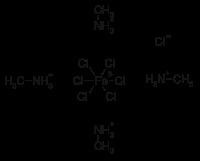Formula (CH6N)4[FeCl6]Cl | Appearance orange crystals | |
Tetrakis(methylammonium) hexachloroferrate(III) chloride is a chemical compound with the formula (CH3NH3)4[FeCl6]Cl.
Contents
Properties
The compound has the form of orange crystals. Six chloride ions are coordinated to the central iron atom leading to octahedral geometry. Interstitial chlorine ions are surrounded by the electrostatically attracted positively charged methylammonium groups. The NH3 groups are bonded to the [FeCl6]3−. The iron within the molecule is in the three coordinate state.
The molecular weight is 432.3 g/mol. The density of this compound is 1.58 g cm−3. Crystal dimensions are 0.25 × 0.35 × 0.16 mm. The melting point is 155 °C. The [FeCl6]3− acts as a Lewis acid, while the ammonium group acts as a Lewis base. It is a hydroscopic compound.
Synthesis
The compound is synthesised by reacting methylammonium chloride, CH3NH3Cl, with anhydrous iron(III) chloride and adding hydrochloric acid with heating. Crystals of the product will precipitate as the solvent evaporates; they are then collected and dried using vacuum desiccation.
Infrared Analysis
There is a series of nitrogen hydrogen amine stretching from 3129 to 2830 cm−1. In addition a distinct peak is found at 2517 cm−1 which corresponds well with the peak at 2476 cm−1 for methylammonium chloride and the literature estimate of a peak present near 2500 cm−1. The 31 cm−1 shift indicates changes in the methylammonium chloride due to coordination with chlorine in the product crystals.

